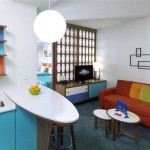```html
Color Scheme Interior Design: A Comprehensive Guide
Color scheme interior design is a fundamental aspect of creating aesthetically pleasing and functional living spaces. It involves the careful selection and arrangement of colors to achieve a desired mood, atmosphere, and overall visual harmony. A well-executed color scheme can significantly impact the perception of space, enhance architectural features, and reflect the personality and preferences of the occupants.
The principles of color theory serve as the foundation for effective color scheme creation. Understanding the color wheel, color relationships, and psychological effects of color is crucial for making informed decisions about color palettes. Interior designers leverage this knowledge to create spaces that are not only visually appealing but also conducive to well-being and productivity.
Choosing a color scheme is not merely about picking favorite colors. It requires a holistic approach that considers various factors, including the room's purpose, size, natural light, existing architectural elements, and desired style. A thoughtful and strategic color scheme can transform an ordinary room into an extraordinary space that meets both aesthetic and functional requirements.
Understanding the Color Wheel and Color Relationships
The color wheel is a visual representation of colors arranged according to their chromatic relationships. It consists of primary colors (red, yellow, blue), secondary colors (green, orange, purple) created by mixing primary colors, and tertiary colors (red-orange, yellow-orange, yellow-green, blue-green, blue-violet, red-violet) created by mixing a primary and a secondary color. Understanding these relationships is key to building harmonious color schemes.
Several established color schemes are based on the color wheel. These include:
Monochromatic: This scheme uses variations of a single color, incorporating different tints (adding white), shades (adding black), and tones (adding gray) to create depth and interest. Monochromatic schemes are often associated with simplicity, elegance, and sophistication.
Analogous: This scheme utilizes colors that are adjacent to each other on the color wheel, such as blue, blue-green, and green. Analogous schemes evoke a sense of harmony, tranquility, and natural flow. They work particularly well in creating serene and calming spaces.
Complementary: This scheme employs colors that are opposite each other on the color wheel, such as red and green, blue and orange, or yellow and purple. Complementary schemes create high contrast and visual excitement. They are often used to draw attention to specific elements or create a dynamic and energetic atmosphere.
Split-Complementary: This scheme uses one color and the two colors adjacent to its complement. For example, using blue with yellow-orange and red-orange. This scheme offers a similar level of contrast to the complementary scheme but is generally considered more subdued and versatile.
Triadic: This scheme involves three colors that are evenly spaced on the color wheel, such as red, yellow, and blue. Triadic schemes are vibrant and visually stimulating. They require careful balancing to avoid overwhelming the space.
Tetradic (or Double-Complementary): This scheme uses two pairs of complementary colors, such as red and green with blue and orange. Tetradic schemes are the most complex and require careful planning to ensure visual harmony. They can be very rich and dynamic when executed effectively.
Factors Influencing Color Scheme Selection
Choosing the right color scheme for an interior space involves considering various factors beyond personal preferences. These factors contribute to the overall success of the design and ensure that the color scheme complements the space and its intended use.
Room Size and Shape: Color can significantly affect the perception of space. Lighter colors tend to make a room feel larger and more open, while darker colors can make a room feel smaller and more intimate. In small rooms, it is generally advisable to use lighter colors on the walls to maximize the feeling of spaciousness. Darker colors can be used as accents to add depth and visual interest. In larger rooms, darker colors can be used more liberally to create a sense of coziness and warmth.
Natural Light: The amount and quality of natural light in a room play a crucial role in how colors appear. North-facing rooms tend to receive cooler, bluish light, which can make colors appear cooler and more muted. South-facing rooms receive warmer, yellowish light, which can enhance warm colors and make cool colors appear more neutral. East-facing rooms receive bright morning light, while west-facing rooms receive warm afternoon light. It is essential to test color samples in the room under different lighting conditions to see how they appear at different times of the day.
Room Function: The intended function of a room should influence the color scheme. Bedrooms often benefit from calming and relaxing colors such as blues, greens, and lavender. Living rooms can accommodate a wider range of colors, depending on the desired atmosphere. Kitchens often benefit from bright and cheerful colors such as yellows, oranges, and reds. Home offices require colors that promote concentration and productivity, such as blues, greens, and grays.
Existing Architectural Elements: The color of existing architectural elements, such as flooring, trim, and fixtures, should be considered when selecting a color scheme. It is important to choose colors that complement or contrast with these elements in a harmonious way. For example, if a room has warm-toned wood flooring, it may be advisable to choose warm-toned colors for the walls to create a cohesive look.
Personal Style: The color scheme should reflect the personal style and preferences of the occupants. It is important to choose colors that they find visually appealing and that create a comfortable and inviting atmosphere. However, it is also important to consider the long-term impact of the color scheme and to avoid trends that may quickly become outdated.
Color Psychology: Different colors evoke different emotions and associations. Understanding the psychological effects of color can help in creating a space that promotes the desired mood and atmosphere. For example, blue is often associated with calmness, serenity, and stability. Green is associated with nature, growth, and harmony. Yellow is associated with happiness, optimism, and energy. Red is associated with passion, excitement, and energy. Purple is associated with luxury, creativity, and spirituality. Orange is associated with enthusiasm, warmth, and creativity.
Implementing a Successful Color Scheme
Once a color scheme has been selected, the next step is to implement it effectively in the interior space. This involves distributing the colors throughout the room in a balanced and harmonious way.
The 60-30-10 Rule: This is a commonly used guideline for distributing colors in a room. It suggests that 60% of the room should be the dominant color, 30% should be the secondary color, and 10% should be the accent color. The dominant color is typically used on the walls, the secondary color is used on furniture and textiles, and the accent color is used on accessories and decorative items. This rule provides a framework for creating a balanced and visually appealing color scheme.
Creating Visual Hierarchy: Colors can be used to create visual hierarchy and draw attention to specific features in a room. For example, a bold accent color can be used on a focal wall to create a point of interest. Lighter colors can be used on the walls to make a room feel larger, while darker colors can be used on furniture to ground the space. The placement of colors should be carefully considered to create a sense of balance and harmony.
Using Color for Emphasis: Colors can be used to emphasize architectural details or highlight specific objects. For example, painting trim in a contrasting color can accentuate the architectural features of a room. Using a bold color on a piece of artwork can draw attention to it and make it a focal point. Color can be used strategically to enhance the visual appeal of the space.
Balancing Warm and Cool Colors: A well-balanced color scheme typically incorporates both warm and cool colors. Warm colors (red, orange, yellow) tend to create a sense of warmth, energy, and excitement. Cool colors (blue, green, purple) tend to create a sense of calmness, serenity, and relaxation. Balancing these colors is important for creating a harmonious and visually appealing space. For example, a room with predominantly cool colors can benefit from adding a touch of warm color to create a point of interest.
Considering Texture and Pattern: Texture and pattern can also influence the perception of color. Textured surfaces tend to absorb more light, making colors appear darker and more muted. Smooth surfaces tend to reflect more light, making colors appear brighter and more vibrant. Patterned fabrics and wallpapers can add visual interest and depth to a color scheme. It is important to consider how texture and pattern will affect the overall appearance of the colors.
Testing Color Samples: Before committing to a color scheme, it is essential to test color samples in the room under different lighting conditions. Paint samples can be applied to a small section of the wall or on a piece of cardboard. Fabric and wallpaper samples can be placed in the room to see how they look with the existing furniture and décor. This allows for evaluating how the colors appear at different times of the day and under different lighting conditions, ensuring the chosen color scheme is suitable for the space.
By carefully considering all of these factors and implementing the color scheme effectively, it is possible to create an interior space that is both aesthetically pleasing and functionally appropriate. The right color scheme can transform a room into a welcoming and inviting space that reflects the personality and preferences of the occupants.
```
How To Choose The Colour Palette For Your Project Alma De Luce

Color Palette Interior Ideas Balance Bedroom Bedroomcolor Design Schemes

Palette For Interior Design Color Ideas

9 Design Ideas For Your Home To Achieve A Green Colour Palette Nippon Paint Singapore

Color Palette For Home 12 Combos Designers Love Havenly Interior Design Blog

20 Best Modern Home Color Palettes Room Combinations Offeo Interior House Colors Combination Palette Living

Color Palette For Home 12 Combos Designers Love Havenly Interior Design Blog

A Complete Guide To Interior Design Colours

87 Interior Design Color Palette Ideas In 2024 Icolorpalette

Living Room Interior Design Color Palette Red And Green








